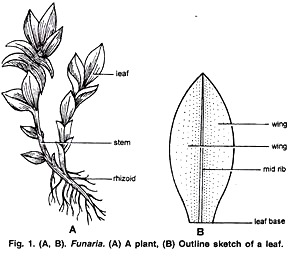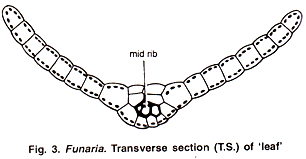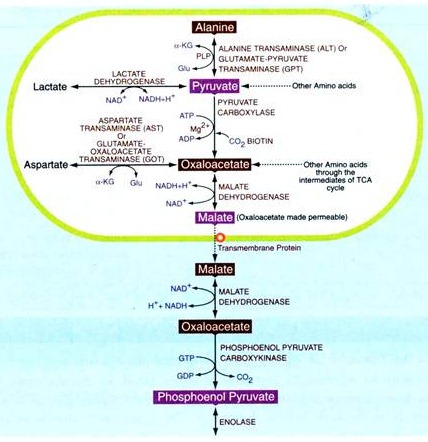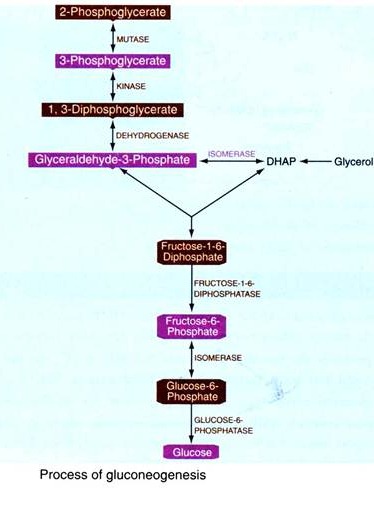In this article we will discuss about the gametophytic phase, reproduction and sporophytic phase in the life cycle of funaria.
Gametophytic Phase of Funaria:
(i) External Features:
Plant body is gametophytic and consists of two different stages namely:
(i) Juvenile stage represented by primary protonema and
(ii) The leafy gametophore which represents the adult form.
The adult gametophyte (gametophore) is differentiated into rhizoids, axis or ‘stem’ and ‘leaves’ (Fig. 1 A). Rhizoids arise from the base of the axis. They are slender, branched, and multicellular and have oblique septa.
Axis is 1—3 cm. high, upright, slender and branched. Each branch is extra axillary i.e., arise below a leaf. Leaves are sessile, oblong-ovate with entire margin, pointed apex and are arranged spirally on the branches and ‘stem’. Each ‘leaf’ is traversed by a single mid rib (Fig. 1B). ‘Leaves’ are borne in 1/3 phyllotaxy which becomes 3/8 at maturity.
(ii) Internal Structure:
1. Axis or ‘stem’
The transverse section (T. S.) of axis can be differentiated into three distinct regions:
(i) Epidermis
(ii) Cortex
(iii) Central conducting strand or central cylinder.
(i) Epidermis:
It is the outer most single layered protective covering consisting of small tangentially elongated chlorophyll bearing cells. Cuticle and stomata are absent (Fig. 2).
(ii) Cortex:
It is present between the epidermis and conducting tissue. It is made up to parenchymatous cells. Younger part of the cortex contains chloroplasts but in the older part they are lacking. At maturity few outer layers of cortex become thick walled and are reddish brown in colour but those of the inner layers become thin walled.
(iii) Central Conducting Strand:
It is made up of long, narrow thin walled dead cells which lack protoplasm. These cells are now commonly called as hydroids. Conducting strand besides providing a certain amount of mechanical support, functions in the upward conduction of water and solutes.
2. Leaf:
Transverse section (T. S.) of ‘leaf’ shows a well-defined midrib with two lateral wings. Except the midrib region, the ‘leaf’ is composed of single layer of parenchymatous polygonal cells. The cells contain many large and prominent chloroplasts (Fig. 3). The central part of the mid rib has narrow conducting strand of thick walled cells which help in conduction.
Reproduction in Funaria:
Funaria reproduces by vegetative and sexual methods.
(i) Vegetative Reproduction:
It takes place by the following methods:
1. By multiplication of primary protonema:
In Funaria, spores on germination form a branched, filamentous, multicellular structure. It’s called primary protonema. In it certain colourless separation cells are formed by intercalary divisions. These cells die out and break up the protonema into single cell or many celled fragments. These fragments grow into new protonemata which bear buds. Each bud develops into a leafy gametophore.
2. By secondary protonema:
When protonema is developed by other than the germination of spore, it is called secondary protonema. It may be developed from any detached living part of the gametophyte such as ‘stem’, ‘leaves’, antheridium, archegonium paraphysis, sterile cells of capsule, seta or when the rhizoids are exposed to sun light in moist atmosphere (Fig. 16 G). It is similar to primary protonema and develops into leafy gametophore.
3. By Gemmae:
During unfavorable conditions, the terminal cells of the protonemal branches divide by transverse, longitudinal divisions and form green multicellular bodies of 10-30 cells (Fig. 4). These are called gemmae. At maturity gemmae become slightly reddish brown in colour. On the return of favourable conditions gemmae germinate and form new plants.
4. By Bulbils:
When such gemmae like structures are produced on rhizoids inside the substratum, these are called bulbils. These are devoid of chloroplasts but capable of developing into leafy individuals under favourable conditions.
5. Apospory:
Development of gametophyte from sporophyte without the formation of spores is known as apospory. Any vegetative cell of the sporophyte may form green protonemal filaments which bear lateral buds. These buds later develop into leafy gametophores.
The gametophores thus formed are diploid. Sexual reproduction in such gametophores results in the formation of tetraploid (4n) zygote. The sporophytes from tetraploid are sterile because they are not capable of bearing spores.
(ii) Sexual Reproduction in Funaria:
Sexual reproduction is oogamous. Male reproductive structure is known as antheridium and female as archegonium. Funaria is monoecious (having male and female sex organs on the same thallus) and autoicous (antheridia and archegonia develop on separate branches of the same thallus). Sex organs are borne on leafy gametophores in terminal clusters.
The main shoot of the leafy gametophore bears antheridia and act as male branch. Female branch develops as a lateral outgrowth from the base of the male branch and bears archegonia. It grows higher than the male branch. Funaria is protandrous (antheridia mature before the archegonia). It ensures the cross fertilization.
Male Branch or Antheridiophore:
Longitudinal section (L. S.) of male branch shows that its apex is expanded and convex shaped. It bears large number of reddish brown or orange antheridia in different stages of development. Projected antheridia are surrounded by a rosette of spreading leaves called perigonial leaves.
The antheridial cluster with surrounding perigonial leaves is called perigonium. The antheridia are intermingled with large number of sterile hair like club shaped structures called paraphyses (Sing, paraphysis) (Fig. 5). Paraphyses store water, protect developing antheridia, help in photosynthesis and dehiscence of antheridia.
Structure of an Antheridium:
The antheridium is club shaped. It can be differentiated into two parts:
(a) Short multicellular stalk
(b) Body of antheridium (Fig. 6K).
Body of antheridium has sterile, single layered jacket of polyhedral flattened cells. When young the cells of the jacket contain chloroplasts which turn orange or reddish brown at maturity. Jacket encloses a large number of androcytes (antherozoid mother cells).
At maturity the distal end of the antheridium bears one or two thick walled, colourless cells called operculum. The opercular cells become mucilaginous, absorb water and swell, break connections with the neighbouring cells and form a narrow pore. Androcytes ooze out in the form of a viscous fluid through this pore.
Development of Antheridium:
Antheridium develops from a single superficial slightly projected cell. It is called antheridial initial. It develops at the apex of the male branch. It divides by a transverse division to form a basal cell and an outer cell (Fig. 6 A, B). The basal cell form the embedded portion of the stalk. The outer cell forms the entire antheridium and is known as antheridial mother cell. It divides by transverse divisions to form a short filament of 2-3 cells (Fig. 6 C).
The lower cells form the lower part of the stalk of the antheridium. The terminal cell of the filament divides by two vertical intersecting walls, thus an apical cell with two cutting faces is differentiated (Fig. 6D).
The apical cell cuts segments in two rows in regular alternate sequence. In this way 5-7 segments cut off (Fig. 6E). Simultaneously when the apical cell is dividing, the third or fourth segments below the apical cell, starts dividing from base, upwards by diagonal vertical walls.
The first wall divides the segment into two cells of unequal size. Small cell is called jacket initial (Fig. 6 F). Larger cell further divides periclinally into an inner large primary androgonial cell (Fig. 6 G) and outer jacket initial. In a transverse section (T. S.) primary androgonial cell appears as a triangular cell (Fig. 6G). Such type of divisions takes place in all the upper segments except the apical cell which develops into operculum.
All the jacket initials divide only by anticlinal divisions to form a single layered wall of antheridium (Fig. 6 H-J). Primary androgonial cells divide and re-divide to form the androcyte mother cells. The cells of the last cell generation are called androcyte mother cells.
Each androcyte mother cell divides further and form two androcytes. Each androcyte produces a single biflagellate sperm or antherozoid or spermatozoid. Each antherozoid is elongated, spirally coiled, bi-flagellated structure (Fig. 6L, M).
Female Branch or Archegoniphore:
The female branch arises from the base of the male branch. Longitudinal section (L. S.) of female branch shows that many archegonia intermingled with paraphyses occurs at its apex (Fig. 7A). The terminal cell of paraphyses is not swollen. The cluster of archegonia is enclosed by a group of green foliage ‘leaves’ called perichaetial leaves. The archegonial cluster with the surrounding perichaetial leaves is called perichaetium.
Structure of an Archegonium:
A mature archegonium is flask shaped structure. It remains attached to the female branch by a massive stalk. It consists upper elongated slender neck and basal globular portion called venter (Fig. 7B).
The neck is slightly tubular, twisted, single layered and consists of six vertical rows of neck cells, which enclose an axial row of ten or more neck canal cells. The venter wall is two layered and encloses venter canal cell and egg cell. Venter canal cell is situated just below the neck canal cells.
Development of Archegonium:
Archegonium develops from a single superficial cell called the archegonial initial (Fig. 8 A). It differentiates at the apex of the female branch. Archegonial initial divides by transverse division to form the basal cell or stalk cell and a terminal cell.
The basal cell divides and re-divides to form the stalk of the archegonium. The terminal cell functions as archegonial mother cell (Fig. 8 B). It divides by three intersecting walls forming three peripheral cells enclosing a tetrahedral axial cell (Fig. 8 C, D). The peripheral cells divide anticlinally to form a single layered wall of venter which later becomes two layered.
The axial cell divides, transversely to form an outer primary cover cell and inner central cell (Fig. 8F). The outer primary cover cell functions as aplical cell with four cutting faces (three lateral and one basal). It cuts off three lateral segments and one basal segment. Each lateral segment divides by a vertical wall so that the six rows of cells form the neck of the archegonium (Fig. G, H). Each basal cell adds to neck canal cell.
The inner central cell divides by transverse division into an outer primary neck canal cell and an inner primary venter cell (Fig. 6H). Primary neck canal cell undergoes transverse divisions to form a row of neck canal cells.
Thus in Funaria the neck canal cells have double origin (lower and middle neck canal cells in the neck canal are derived from the primary neck canal cell while those in the upper portion of neck are derived from the primary cover cell). The primary venter cell divides by transverse division to form the venter canal cell and egg cell (Fig. 8 I, J).
Fertilization in Funaria:
Water is essential for fertilization. The opercular cells of the antheridium rupture and releases mass of antherozoids. When archegonium reaches at maturity, the neck canal cells and venter canal cell disintegrate to form a mucilaginous mass. It absorbs water, swells up and comes out of the archegonial mouth by pushing the cover cells apart. This mucilaginous mass consists chemical substances (mainly sugars).
The cover cells of the neck separate widely from each other and form a passage leading to the egg. Rosette like perigonial leaves serve as splash cup from which rain drops disperse antheroziods to some distance (rain drops falling on the archegonial cluster situated at lower level).
Many antherozoids enter the archegonial neck because of chemical response but only one of them fuses with the egg to form the zygote. Union of male and female nuclei is complete within 10 hours. Fertilization ends the gametophytic phase.
Sporophytic Phase:
Zygote is the first cell of the sporophytic phase. Development of sporophyte takes place within the venter of the archegonium.
Structure of Sporophyte:
The sporophyte is semi-parasitic in nature, the mature sporophyte can be differentiated into three distinct parts—foot, seta and capsule.
(i) Foot:
It is the basal portion of the sporogonium. It is small dagger like conical structure embedded in the apex of female branch. It functions as anchoring and absorbing organ.
(ii) Seta:
It is long, slender, stalk like hygroscopic structure. It bears the capsule at its tip. It raises the capsule above the apex of leafy gametophore. Its internal structure is more or less similar to axis. The epidermis is followed by thick walled cortex which surrounds the axial cylinder. It is mechanical in function and also conducts the water and nutrients to the developing capsule (Fig. 10).
It is the terminal part of the sporophyte and is developed at the apex of the seta. It is green in colour when young but on maturity it becomes bright orange coloured. It is covered by a cap like structure called calyptra. (gametophytic tissue develops from the upper part of the archegonium).
Internal Structure of the Capsule:
Longitudinal Section (L.S.) of the capsule shows that it can be differentiated into three distinct regions-apophasis, theca and operculum (Fig. 11A).
(a) Apophysis:
It is the basal sterile part of the capsule. It is bounded by the single layered epidermis which is interrupted by stomata. The sotmata have single ring like guard cells (Fig. 11 C, D). Below the epidermis is spongy parenchyma. The central part of the apophysis is made up of elongated thin walled cells forming a conducting strand. It is called neck of the capsule. It is the photosynthetic region and connects seta with capsule.
(b) Theca:
It is the middle, slightly bent spore bearing region of the capsule. It lies between the apophysis and operculum.
Longitudinal section (L. S.) passing through the theca shows the following regions:
(i) Epidermis:
It is the outer most layer. It is single layered with or without stomata.
(ii) Hypodermis:
It is present below the epidermis. It consists two to three layers of compactly arranged colourless cells.
(iii) Spongy parenchyma:
It consists two to three layers of loosely arranged chlorophyllous cells. It is present inner to hypodermis. These cells are capable to manufacture their own food but dependent on gametophyte for water and mineral nutrients. Therefore, the sporophyte of Funaria is partially dependent on gametophyte.
(iv) Air spaces:
These are present just below the spongy parenchyma and outside the spore sacs. Air spaces are traversed by green cells (chlorenchymatous cells) called trabecular (elongated parenchymatous cells).
(v) Spore sac:
These are present below the air spaces on either side of the columella. It is ‘U’ shaped and broken at the base. (It separates its both arms).
It has an outer wall (3-4 cells thick) and an inner wall (single cell in thickness). Between the outer wall and inner wall is the cavity of the spore sac. When young, the cavity of the spore sac is filled with many spore mother cells. At maturity the spore mother cells divide by meiotic divisions and form many haploid spores.
(vi) Columella:
It is the central part of the theca region. It is made up of compactly arranged colourless parenchymatous cells. It is wide above and narrow below, connecting the central strand of apophysis. It helps in conduction of water and mineral nutrients.
(c) Operculum:
It is the upper region of the capsule. It is dome shaped and consists four to five layers of cells. The outermost layer is thick walled and called epidermis. Operculum is differentiated from theca by a well-marked constriction. Just below the constriction there is a diaphragm (rim). It is composed of two to three layers of radially elongated pitted cells.
Immediately above the rim is annulus which consists of 5-6 superimposed layers of cells. Its upper cells are thick but two lowermost layers of cells are thin. Annulus separates the theca from the operculum. Below the operculum lies the peristome (Fig. 11 B). It is attached below to the edge of the diaphragm. The peristome consists of two rings of radially arranged peristomial teeth. In each ring there are sixteen teeth.
The teeth are not cellular but they are simply the strips of the cuticle. The teeth of the outer ring are conspicuous, red with thick transverse bands while the teeth of the inner ring are small, delicate, colourless and without transverse bands. Inner to peristome teeth lies a mass of thin walled parenchymatous cells. (Fig. 1 IB).
Development of Sporophyte:
Soon after fertilization, the zygote secretes a wall around it and enlarges in size. It divides by a transverse wall forming an upper epibasal cell and lower hypo basal cell (Fig. 12 A, B). Epibasal cell divides by two intersecting oblique walls. It differentiates an apical cell with two cutting faces in the epibasal cell (Fig. 12C). Similarly, the hypo basal cell differentiates an apical cell (Fig. 12 D).
The entire sporophyte is differentiated by the activity of these two apical cells. So, the development of embryo sporophyte is bi-apical. Epibasal apical cell develops into capsule and upper portion of the seta while the hypo basal apical cell develops into foot and remaining part of the seta. Both apical cells cut out alternate segments and form the elongated filamentous structure of young sporogonium (Fig. 12 E, F).
Development of Capsule:
A cross section through the upper portion of the young sporogonium shows a two identical segments (Fig. 13A) which divide by a vertical division at right angle to the previous one to form a quadrant (4 celled stage) (Fig. 13B).
Each cell of the quadrant divides by anticlinal wall (Fig. 13C) in such a way that a smaller almost triangular cell and a larger more or less rectangular cell is formed. Each rectangular cell now divides by a periclinal division (Fig. 13D).
It results in formation of a group of four central cells surrounded by 8 peripheral cells. The central tissue is known as endothecium and the peripheral cells from the amphithecium (Fig. 13D). From these two group of cells the further development takes place. There is formation of different rings by anticlinal and periclinal divisions.
The amphithecium divides by periclinal division to form two concentric layers. The inner layer of 8 cells is called first ring (Fig. 13E). The cells of the outer layer divide by anticlinal divisions to form 16 cells (Fig. 13F). This is followed by the periclinal division in this layer.
The inner part of this layers is called the second ring (Fig. 13G). Again the outer layer of these two layers divides anticlinally to form 32 cells. This layer divides periclinally to form two layers of 32 cells. The inner layer is called third ring. Similarly by periclinal divisions fourth and fifth ring of 32 cells are formed (Fig. 13G-I).
The four cells of the endothecium also divides similarly to amphithecium. The first division is curved and anticlinal (Fig. 13F). The second division is periclinal (Fig. 13G). It results in the formation of a central group of 4 endothecial cells, surrounded by 8 peripheral endothecial cells. Further development of the tissues in the capsule region takes place by these amphithecial rings and endothecial cells.
It can be studied under the following three headings (Fig. 13H-I). Development of fertile (theca) region (middle portion of young capsule):
The fertile region in capsule comprises archesporium lined by outer and inner spore sac. Archesporium is endothecial in origin. Its cells may undergo sub-divisions to form two cell layers thick spore mother cells which by meiosis form tetrad of spores. Elaters are absent.
Dehiscence of the Capsule:
Funaria is a stegocarpous moss (dehisce along a pre-determined line) Dehiscence of the capsule is achieved by ‘breaking off’ of annulus. As the capsule matures it becomes inverted due to epinasty. The thin walled cells of the annulus break away, the operculum is thrown off and the peristome teeth are exposed.
The outer peristomial teeth (exostome) are hygroscopic. The inner peristomial teeth (endostome) do not show any hygroscopic movements but act as a sieve allowing only a few spores to disperse at a time. The lengthening and shortening of the outer peristomial teeth help in the dispersal of spores.
In high humidity the exostome absorb water, increase in length and curve inwards. In dry weather, the exostome teeth lose water, bend outwards with jerky movements. It allows the dispersal of spores from the capsule in instalments. At maturity the seta also shows jerky movements. Twisting and swinging of seta in dry weather further aids in the dispersal of spores.
Structure and Germination of Spore:
Spore is the first cell of the gametophytic phase. Each spore is spherical (Fig. 15A), 12-20 µ in diameter and surrounded by two wall layers (Fig. 16 A). The outer wall is thick, smooth, brown and known as exosporium, while the inner wall is thin, hyaline and called endosporium. Spore wall encloses single nucleus, chloroplasts and many oil globules.
Under favourable conditions (sufficient moisture) spores germinate. Exosporium ruptures and endosporium comes out in the form of one or two germ tubes (Fig. 16B, C). Each germ tube is multicellular, green with oblique septa. The germ tube grows in length, divides by septa to form green algal filament like structure called primary protonema (Fig. 16 D, E).
Primary Protonema:
It is the juvenile (young) stage of the gametophyte formed by the germination of spore. It forms two different types of branches.
Most of the branches grow horizontally on the moist surface of the soil and are known as chloronemal branches (positive phototrophic, thick and rich in chloroplast) while some branches grow down in the soil and are called rhizoidal branches (non-green, thin and possess oblique septa) (Fig. 16F). These branches can develop chlorophyll if expose to light.
Rhizoidal branches function as anchoring and absorbing organs while chloronemal branches develop minute green buds behind the cross walls which develop into leafy gametophores. From one primary protonema many moss plants develop, so the moss is gregarious in habit. Primary protonema is short lived.
According to Sirnoval (1947) development of protonema under laboratory conditions can be differentiated into two stages—chloronemal stage and caulonemal stage. Chloronemal stage is characterised by irregular branching, right angle colourless cross walls, and many evenly distributed discoid chloroplast.
It is positive phototropic but never produce buds. Nearly after 20 days chloronemal stage matures into caulonemal stage. This stage is characterised by regular branching brown cell walls, oblique cross walls and fewer chloroplasts. It is negative phototropic and produce buds which later develop into leafy gametophores. Rhizoids arise from the base of a bud (Fig. 16G. 17, 18).




















